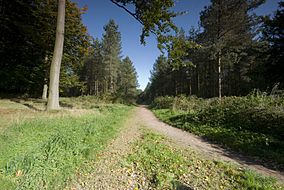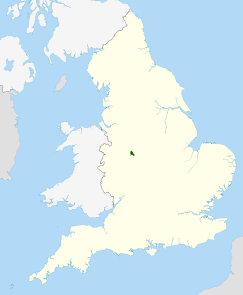Cannock Chase facts for kids
Quick facts for kids Cannock Chase |
|
|---|---|

Cannock Chase AONB
|
|

Location of Cannock Chase AONB in the UK
|
|
| Location | Staffordshire, England |
| Established | 1958 |
Cannock Chase is a beautiful area in Staffordshire, England. It has lots of woodland and open countryside. This special place is known as the Cannock Chase Area of Outstanding Natural Beauty. The name "Cannock Chase" is also used for the local government area nearby.
Cannock Chase is located between the towns of Cannock, Lichfield, Rugeley, and Stafford. It's a mix of different landscapes. You'll find natural forests with trees that lose their leaves in autumn (called deciduous trees). There are also areas with coniferous trees, which are evergreens like pines. Large open areas of heathland are also part of the Chase. You can even see signs of old industry, like where coal mining used to happen.
Contents
Why is Cannock Chase Special?
Cannock Chase was officially named an Area of Outstanding Natural Beauty (AONB) on September 16, 1958. This means it's a very important landscape that needs to be protected. Even though it's not a huge area, Cannock Chase has an amazing variety of scenery and wildlife.
Much of the Chase is also a Site of Special Scientific Interest (SSSI). This is another important title that helps protect the area's special plants, animals, and geology.
Amazing Wildlife and Nature
Cannock Chase is home to many animals. You can often spot a herd of about 800 fallow deer roaming freely. These deer are a common sight for visitors.
The Chase is also a great place for birdwatching. There are some rare and endangered birds that visit, like the Nightjar. These birds travel long distances during their migration. A special feeding station helps attract many different bird species. You might see colourful birds like Bramblings, Yellowhammers, and Bullfinches there.
Efforts are being made to grow more heathland on the Chase. This involves bringing back plants like heather. In some places, plants like bracken and birch trees have grown too much. By managing these areas, more space is created for the unique heathland plants to thrive. You can also find a special berry here called the Cannock Chase Berry (Vaccinium ×intermedium).
Historic Places and Fun Activities
On the north-eastern side of Cannock Chase, you'll find Shugborough Hall. This grand old house was once the home of the Earls of Lichfield. It's a fascinating place to visit and learn about history.
At the southern edge of the Chase are the remains of Castle Ring. This was an Iron Age hill fort, built by people long ago. It's also the highest point on Cannock Chase, offering great views. You can also find large rocks called glacial erratic boulders scattered around. These rocks were left behind by glaciation (ice sheets) from thousands of years ago. One of them is even displayed on a stand.
Since 2006, Cannock Chase has become a popular spot for outdoor music concerts. The Forestry Commission hosts its nationwide Forest Tour here. Famous bands and artists like The Zutons, The Feeling, Status Quo, and Jools Holland have played in a clearing in the forest. It's a unique way to enjoy music in a natural setting.
How the Landscape Formed
The landscape of Cannock Chase was shaped a lot by the rocks underneath. These rocks are called "bunter" formations and are from the Triassic period. They are made of sandstone that contains rounded pebbles.
These types of rocks can be found in many parts of England, including Warwickshire, Cheshire, Staffordshire, Nottinghamshire, Yorkshire, Devon, and Dorset. Scientists believe they are alluvial deposits. This means they were laid down by ancient rivers. The pebbles are very rounded, which suggests they were carried for a very long time in a large, fast-moving river. The hard pebbles were worn smooth by powerful abrasion. It's thought that the deposits in the English Midlands were carried north from a region called Brittany in northern France.
See also
 In Spanish: Cannock Chase para niños
In Spanish: Cannock Chase para niños


